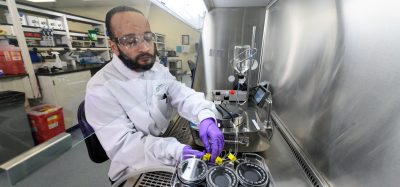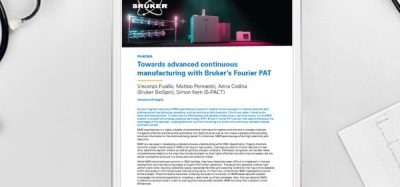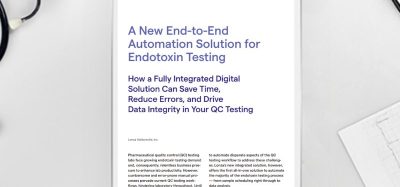Lab Automation Roundtable
Posted: 12 December 2009 | EPR interviews | No comments yet
Participants: Dr Gordon R Alton, President and CEO, Altonyx Consulting / Dr Scott Bowes
Scientist, Novartis / Dr Sheraz Gul, Vice President and Head of Biology, European ScreeningPort /
Chris Molloy, Vice President of Corporate Development, IDBS


Dr Gordon R Alton, Dr Scott Bowes, Dr Sheraz Gul and Chris Molloy discuss Lab Automation in this European Pharmaceutical Review roundtable discussion.
1. What do you feel are the current changing attitudes towards Lab Automation?
Alton: More companies then ever are seeking to accelerate testing cascades with fewer FTEs involved. Previously some companies were reluctant to spend capital on automation equipment. This is now changing. So the current attitude now is that bringing automated workstations into the lab makes a lot of sense and ultimately can lead to reduced testing costs. Additionally, there is a shift in thinking about training. Increased training leads to more effective work flows as the more experienced user can program more complicated routines. Also, more companies are considering long-term maintenance contracts that reduce instrument down-time and allow for enhanced experimental reliability. Taken together these attitude shifts really mean that more companies are willing to commit capital, reagent and training budgets to optimise the automation solution.
Bowes: The perception in the past was that scientists were doing science at the bench and technologists were working with automation. As the industry has matured, those two disciplines have blended to become almost indistinguishable. The stigma of the possible commoditisation of science has largely been supplanted with the now perceived benefits of automated processes. Initially, “hard-core” scientists may have been uninterested or even intimidated by lab automation, the benefits of which were not clear. Today’s bench scientist has to be familiar with a host of instruments, many of which could be considered automated. Automation on a larger scale has brought to the lab a host of new possibilities, improving data quality by decreasing variability and increasing capacity for many processes. Lab automation is now being embraced as empowering rather than a threat to job security.
Gul: We have seen the installation of a vast amount of equipment capable of performing tasks in an automated fashion within pharmaceutical companies. The aim of this was in part to increase throughput, reduce variability and cost i.e. improve the overall productivity of tasks that were previously performed manually. Despite these laudable aims it has become apparent that these initiatives in general have not improved the productivity when taking stock of the discovery of new marketable medicines. The idea that installing a fully automated platform will overcome the requirement for any human intervention/oversight does not appear to have materialised and the relentless industrialisation of Drug Discovery appears to have been somewhat ill-conceived.
In addition, within the large pharmaceutical companies we are seeing increased activity with respect to mergers and acquisitions, product in-licensing and the outsourcing of existing R&D activities. The result of this will be a reduction in automation within these organisations. However, contract research organisations and the academic sector can potentially benefit from such downscaling of activities. These organisations have lower budgets and vendors are under pressure to produce lower cost hardware whilst maintaining their quality.
Molloy: There remain differing attitudes towards Laboratory Automation between large and small organisations in the established markets. However, these are less extreme than was the case five to ten years ago and also there is the new factor of an increase in demand for proven laboratory automation across Asia-Pacific (APAC) as this region becomes a major player in global drug discovery. Larger organisations are still investing in significant high-throughput automation platforms for new technologies, such as High Content Analysis (HCA) whilst trying to ensure return from their significant investment in existing large platforms for established – but still relevant – technologies. At the same time these larger companies are joining smaller organisations in implementing turnkey platforms and benchtop systems across a range of technologies, from HCA to label-free and analytical technologies. These systems allow organisations to follow the cellular-manufacturing theory of automation and, for the lower-throughput and smaller companies who cannot leverage an economy of scale, exploit the new entry-level instrument technology and a lower overall cost of ownership (COO).
2. Which specific areas of drug discovery are benefitting most from the latest Lab Automation technology?
Alton: Without a doubt the use of automated workstations for cellular assays of all types is markedly increased. This includes ELISA style assays as well as phenotypic assays that monitor endpoints such as cell number, apoptotic processes, or morphology/migration. Furthermore, the use of high content imaging automated workstations for analysis of secondary biology and mechanism of action is really taking off. This permits much faster characterisation of putative biomarkers than traditional fluorescent microscope studies. So the main area of benefit is in the area of secondary pharmacology impacting translational biomarkers.
Bowes: The areas of drug discovery benefiting the most are in High Throughput Screening, and Preclinical Safety Profiling. Automated cell culture systems that grow and plate cells for drug screening are greatly beneficial for both reducing the risk of contaminating cell lines and improving the quality of life for the scientists responsible. Carrying multiple cell lines no longer requires the complex timing of counting and splitting flasks of cells. Large incubators, integrated with screening platforms, have improved innovative companies abilities to run massively parallel processes against many different cell lines. As the scheduling software on automation has become more sophisticated, running panels of assays with multiple formats, incubation times, read-outs, etc. have become commonplace. Having the in-house capability compared to outsourcing the testing of early lead candidates for safety profiling provides a more efficient turn-around time and is less costly to the company.
Gul: It is clear that automation of various processes in Drug Discovery is essential. In pre-clinical Drug Discovery we have seen molecular biological techniques, protein expression and purification, cell culture scale-up, protein crystal production, high throughput compound synthesis, compound handling and compound screening activities all having undergone significant automation. The sequencing of the human genome has resulted in the identification of numerous proteins for potential therapeutic intervention. With the concomitant synthesis and compilation of large libraries of compounds as potential starting points for Drug Discovery, it was thought that screening of such libraries of such compounds against the potential targets would revolutionise Drug Discovery but this has not materialised.
Occasionally, developments are made that are revolutionary and thus enable activities to be performed that were previously not possible (or only possible at significant material or time cost). One example here is the contactless transfer of liquids from source to destination microtitre plates. This type of liquid transfer was initially only possible for liquids predominantly containing DMSO which is a standard solvent used to dissolve compounds and is subsequently used in compound screening activities. However, this method of dispensation has now been successfully extended to other liquids. Overall, this technology has proved to be extremely versatile and new applications are being devised and reported in the literature.
Although automation in compound screening activities in Drug Discovery has resulted in an increase in the metrics of an organisation with respect to the amount of data that is generated, there is still a significant shortfall with respect to the numbers of new medicines that have been discovered.
Molloy: We see a number of different areas benefitting from the new technologies coming to market. Amongst many of these technologies, uHT sequencing continues to evolve, providing dramatic time and cost improvements to target identification and validation. Intriguingly this opens the door to what may be one new facet of the Translational Medicine story: personalised drug discovery. This is the logical extension of Personalised Medicine, where genomics drives treatment options; improved drug target gene-profiling may allow the simultaneous search for new leads and candidates active against different genotypes of the same disease (or disease sub-type) target, providing clinical development organisations with portfolios of candidates to be examined in genetically relevant cohorts. Personalised medicine, through the many ‘omics initiatives is already benefitting from the increased use of Affmetrix and Illumina technologies and we believe that the advent of miniaturised NMR products will have a dramatic impact upon this sector – as did the miniaturisation of mass spectrometry. The growth area of therapeutic biologicals discovery is enabled on an industrial scale, and is increasingly dependant upon, easy-to-use, robust label-free screening technologies. HCA is providing widespread benefit across many areas of drug discovery as the rise in cell-based screening seen across target classes and industry sectors.
3. How has the industry changed over the past five years and what are the impacts of this?
Alton: The main suppliers of instrumentation have been cognisant that client companies are willing to spend money on automation equipment but the bottom line of cost containment is crucial. In other words what value does a certain instrument bring to the laboratory? Instrument suppliers have responded with smaller, modular workstations that are very easy to program and are more flexible in the types of operations that they can perform. As the requirements change at client companies concerning what the automation instrument can deliver (i.e., run different types of assays) relatively inexpensive upgrades can supply greater flexibility. Additionally, instrument manufacturers have recognised that older instrument platforms installed at client companies can be a valuable source of income by supplying software upgrades or “bolt on” hardware that can expand the range of capabilities. So, for client companies that don’t have the capital budget to buy state of the art instruments they can still increase productivity by retooling older instruments.
Bowes: Lab automation in the pharmaceutical and biotech industries has matured over the last five years, but still has a long way to go. The MTF, (mean time to failure) rates for automated systems in this industry would be completely unacceptable in others. It is as if we have convinced ourselves that what we do is so complicated that it is not surprising that our systems crash. All too often we have come to accept that crashes and down-time is inevitable for large automated systems. This has become a pervasive, somewhat self-fulfilling notion.
Gul: The drug discovery industry has undergone considerable consolidation. There has been a move towards demanding more from vendors when considering automating processes. Whereas in the past it would have been commonplace to accept what vendors were offering, their products are now scrutinised more prior to committing to a purchase. Simple modular systems tend to be more versatile than the larger complex automated platforms and these now appear to be the preferred choice when considering a new purchase. Although the pharmaceutical companies have been the mainstream organisations engaged in automation, many of such initiatives have failed to deliver as expected. In many instances equipment is purchased that offers a limited advance upon what is already installed and this may not be a worthwhile expense to be paid if rolled out across an organisation.
In addition to this, academic institutions becoming engaged in Drug Discovery and thereby attempting to exploit their internal research efforts and suppliers have had to respond by designing and developing appropriate automation solutions for a wide variety of customers with different capabilities and budgets. With this change in customer base, there are also many newcomers who are promoting alternative, novel and sometimes cheaper automation solutions.
Molloy: There are technological, economical and geographical answers to this question. Technologically, although 1536 based platforms, tools and technologies were available for biochemical screening five years ago, the increased emphasis upon cell-based screening has – for the time being – reached an equilibrium with 384 platforms focussing upon label-free and HCA systems. Screening libraries seem to have been retained at reasonable numbers and the use of increased chemoinformatics support for discovery has limited the requirement for inexorable rises in the number of wells screened per target. Economically organisations are demanding lower costs of ownership and reduced complexity in platforms. Vendors have innovated accordingly and we are seeing smaller, more affordable and more robust technologies coming to market. Geographically we are seeing increased demand in APAC for small platforms or proven benchtop systems and technologies. These provide a rapid acceleration of capability development for APAC’s growing pharmaceutical and contract research (CRO) sector without being reliant on complex support contracts or integrations: improving quality and reliability of output at the most reasonable price.
4. How do you see Lab Automation developing over the next five years?
Alton: The cost pressure on drug discovery companies, large and small, is intense. Capital budgets are still available, but substantially smaller than in previous years. Companies purchasing automation solutions are looking at the bottom line costs of the different instruments on the market. I see automation providers scaling down the physical size of the instruments and going to an increasingly modular approach. Furthermore, software development will continue to focus on visual programming that allow users to do “drag and drop” programming with a minimum of data inputs. Increased use of “wizards” that guide users through set-up and operation are a clear area for development. I anticipate that the automation instruments of the future will be substantially less expensive than today. Moreover, automation solution providers are more likely to attempt to improve profit margins not through selling the instrument but rather through long-term contracts to deliver the reagents and supplies that are used.
Bowes: Industrial grade robotics will become more commonplace in our industry. Manufacturers of robotics systems from other industries like auto and food will modify and expand their reach into the life sciences. Companies will begin to demand more reliability and improved performance from their automated systems.
Gul: I will expect to see an increase in contract research organisations and academia becoming engaged in activities that require Lab Automation which were previously perceived to be the speciality of the pharmaceutical companies. These organisations are more restrained with respect to their budgets and as a result vendors will need to adapt to their new customer base as they will demand cheaper equipment whilst retaining quality. Automation will remain an essential component within the pharmaceutical companies but a more conservative approach by them will probably be taken in future. For example, there are an extensive range of liquid handlers commercially available with a wide price range. However, we are seeing that there is an upper limit that customers are willing to pay for such technologies as well as other hardware. Control software that is more user friendly will also be more commonplace as much of the current automated platforms are often too complex to be used without significant training. The current attrition rate of compounds that are transitioned from pre-clinical to clinical stages is unacceptable and needs to be addressed. This will in part be possible by the automation of assays that have direct clinical relevance, even though they tend to be more complex than those that make use of single targets.
Molloy: Bearing in mind the continuing negative trend of cost vs. output in discovery, COO must continue to come under increasing scrutiny. The acquisition of new technologies will continue but these will have to encompass not only the acquisition of data but the use of those data too. The days when each automation/technology vendor developed custom formats, algorithms and outputs should soon be over. Scientists may not in reality expect all their vendors to join up in a Utopian consortium but should expect all data generated by their equipment to be accessible, searchable and secured. This will require automation vendors to work closely and strategically with data management providers – as many have begun to do – and it is my belief that those who continue to resist this and either disregard informatics – or use custom formats as a ‘lock-in’ tool will become increasingly isolated. Electronic Laboratory Notebooks (ELNs) such as IDBS’ E-Workbook and data management systems such as ActivityBase are the tools which provide computation, consistency and security for data and are increasingly the data backbone for discovery groups. Allowing such systems to handshake effectively with automation, and play to their strengths, frees the automation vendor to focus on technology and cost-control whilst providing scientists with the desired one-stop-shop interaction with their high-tech data, whatever the source.
5. What major challenges is the industry currently facing?
Alton: The most significant challenge facing the automation industry is that many drug discovery companies are going out of business at an unprecedented rate. Even large pharmaceutical companies are merging and downsizing at a pace that was not imagined even a few years ago. The dearth of venture capital has led to a situation in which drug discovery companies are significantly paring back on purchases. So, as the market shrinks there may be too many suppliers of automation solutions to survive the next few years. Other industries beyond drug discovery have yet to significantly impact bottom line sales for automation suppliers. It is anticipated that a wave of mergers and acquisitions for automation suppliers will occur and only the companies with very tight cost controls and highly efficient sales forces will survive.
Bowes: Because of the specialised nature of what we do, there is a tendency to integrate bench top instruments into an automated platform. Part of the problem is that some of these system components are not designed to run at the capacity a fully automated platform may demand. The 24/7 nature of some automated platforms demand that all associated components be reliable. Any integrated system is only as robust as its weakest component.
Gul: A major challenge the pharmaceutical companies is facing is the lack of their ability to fill their pipelines with potential medicines that will enable an income to be generated from their subsequent sale. Although a number of reasons are commonly cited for the lack of internal productivity, there appears to be no quick fix. The fundamental scientific understanding of disease mechanisms needs to be improved upon as biological phenomena are extremely complex. One method to address this that is taking shape has been to form consortia with various collaborators e.g. pharmaceutical companies who have the technical know-how and world-class academic laboratories that have a deep understanding of disease associated targets. Despite this challenge, significant rewards await those who will be able to discover medicines for diseases that currently do not have a suitable method of treatment.
Molloy: There is no shortage of challenge for the industry today; the requirement for greater efficiency and continuous business improvement (CBI) remains a constant as well as a core justification for Laboratory Automation. However the recent, impacts of cost-reduction and globalisation of research activities have had a critical impact. Discovery activities are now expected to be undertaken with reducing numbers of staff and internal resources. This industry sector was, during its rapid evolution, highly capital intensive, technology/vendor-driven and ever-expanding. Naturally this could not go on forever and it has gone through a rapid maturation. It is now entering an uncertain period of contraction in its established markets, refocusing on cost-control and core competencies. Is this a mid-life crisis? No, there is no need to panic. However, as in mid-life there is a requirement to reassess and focus on the things which are most important to success. In this we believe that there are two themes: firstly that new technologies will now only be brought through in established markets if they show rapid ROI or reduce COO and; scientists will increasingly focus upon the output of the technology – the data – and expect this to be seamlessly managed, secured and retrievable, particularly as technologies supporting HCA, NMR, and label free analysis provide increasing volumes and complexity of data and metadata.
It is not all doom and gloom. The new focus area of Translational Research is an exciting and invigorating challenge for the industry. This area of endeavour is the combination of clinical and biological information and helps the industry move into more focussed, effective, safer therapies for patients, mindful of the genotype and the sub-type of disease they suffer with. Key to this activity, which is now in a similar state of explosive growth the screening area of old, and is playing a vital role in biomarker discovery, is the application of technologies to better measure ‘omic profiles and the effective use of informatics to combine such diverse data types, mine the literature and other external sources and help in drawing vital assumptions between markers of disease and discrete cohorts of patients.
The globalisation of discovery activities will enforce some standardisation of equipment for a majority of discovery sectors, either because clients demand this of their CRO’s or standards emerge through common use. It is a positive challenge for vendors to establish these de facto standards but also for the discovery industry to define what the basic tools are and stick to them, grinding out efficiency and consistency. Internally, discovery organisations may achieve competitive advantage in niche acquisition and use of new technologies; however the ease by which organisations worldwide can now adopt and utilise many of these tools – once robustly commercialised – makes this technology advantage time limited and questionable.








